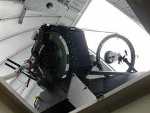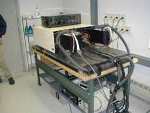More than two years after road access and electrical power to the Mauna Loa Observatory was cut off by lava flows, NOAA staff continue to make critical measurements of the atmosphere and other environmental variables at the remote site.
In 2023, observatory staff installed solar panels at the site and resumed some measurements, including the independent carbon dioxide monitoring programs run by the Global Monitoring Laboratory and Scripps Institution of Oceanography, as well as other atmospheric measurements.
Construction of a temporary road to access the observatory site is anticipated to begin in summer 2025.
Media can contact: Theo Stein (303) 819-7409 (theo.stein@noaa.gov)
Organization(s):
 Partnering organizations in the project are:
NOAA, University of Hawaii, Mount Washington Observatory, Michigan Aerospace Corporation.
Partnering organizations in the project are:
NOAA, University of Hawaii, Mount Washington Observatory, Michigan Aerospace Corporation.
What does this program measure?
The GroundWinds LIDAR instrument is a technology demonstration of a ground system that might later be deployed on a satellite platform. The LIDAR system measures the velocity and direction of winds up to 20km. We are able to measure wind velocity down to 1m/s.
How does this program work?
View a schematic diagram of the Groudwinds Lidar System
The LIDAR transmits short pulses of laser light (355nm) along the optical axis of a telescope into the
atmosphere. The 5W laser light is scattered by the molecules and aerosols in the atmosphere resulting in a
detectable back scattered light signal. At each altitude, the scattered laser light returns to a receiver
telescope. A fiber optic cable carries the scattered light from the telescope to an interferometer system. A
comparison is made of the outgoing and incoming laser pulses using the Doppler shift. The instrument operates
continuously at Mauna Loa.
Why is this research important?
Presently, wind measurements are made by an instrument called a radiosonde. It is only capable, however, of making these measurements over land masses and only at set intervals of time. The Groundwinds technology is capable of being put onto a satellite platform to make global wind measurements, especially over the oceans where critical wind data is unavailable.
Are there any trends in the data?
The instrument was put into full operation in March of 2003. The data is currently being analyzed in conjunction with the University of Hawaii on a ongoing basis.
How does this program fit into the big picture?
What is it's role in global climate change?
Once this instrument is put onto a satellite platform orbiting the earth, it will provide more accurate global wind measurements thereby improving weather forecasting.
Comments and References
The GroundWinds instrument is a technology demonstration of a ground system that might later be deployed on a satellite platform. The GroundWinds direct detection Doppler lidar system utilizes a two-channel Fabry-Pérot interferometer as a high spectral resolution element, capable of detecting Doppler shifts of the back scattered signal corresponding to velocities less than 1 meter per second (1 m-s-1). This interferometer is the direct descendant of the High Resolution Doppler Imager (HRDI) (Hays, et al, 1993) employed on the Upper Atmosphere Research Satellite (UARS) and the Fabry Perot Interferometer (FPI) (Hays et al, 1981) employed on the Dynamics Explorer (DE). The GroundWinds lidar consists of a laser transmitter that transmits a narrow pulse of nearly single frequency light, and a receiver that measures and records the frequency shifts in the back scattered laser light. The receiver measures the spectrum of back scattered light at a high rate. These spectra are analyzed to deduce the Doppler shift of the light as a function of altitude. This spectrum consists of two components: a broad component from the Rayleigh scattering from atmospheric gases, and a narrow component from the Mie scattering from atmospheric aerosols. The GroundWinds system employs both components to measure the wind velocity. The aerosol component, when present, provides an accurate wind measurement, but aerosol concentrations vary greatly with geographic location, altitude, season, and even time of day. However, the molecular component is always present, and we use it as the primary source of information to measure the winds. Each of these components is measured independently with different interferometers designed for that component. Figure 1 (click here to view) illustrates how transmitted laser light, that has been scattered by the atmosphere, is gathered by a telescope and processed by the detection system.
Lead Investigator(s):
Dr. Berrien Moore (UNH)
603-862-1727
Ivan Dors
603-862-2867
MLO Contact(s):
John E. Barnes
808-933-6965 (x222)
David Nardini
808-933-6965 (x229)
Web Site(s)
http://groundwinds.sr.unh.edu/
Date Started
March, 2002



